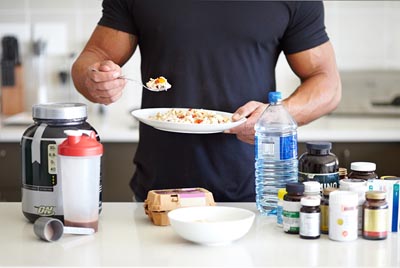 While there are variables when it comes to the amount of protein we should include in our diet for optimal health, many of us active folks focused on fitness could benefit from a high protein diet.
While there are variables when it comes to the amount of protein we should include in our diet for optimal health, many of us active folks focused on fitness could benefit from a high protein diet.
Because your protein can come from whole foods from both animals and plants and supplements like powders and food products like bars, we compare a few easy sources you can count on.
We asked one of our resident experts, XSport’s National Director of Operations Ernie Rizzato, to tell us why a high protein diet can be a good idea, and to share some classic ways to make it happen.
Ernie mentions that recent research continues to demonstrate the potential benefits of adding protein to the average diet, especially for those who are trying to slim down, get lean, build muscle or support physical performance. Studies have shown:
- Even when overall calories are the same, a diet that is higher in protein was found to lead to more fat loss than a lower protein diet.
- More muscle is preserved, and/or gained with a high protein diet (keeping calories the same again).
- Less belly fat is another benefit attributed to a high protein diet. It’s also more difficult for your body to convert protein into body fat than other macronutrients
So what is “higher” as far as a high protein diet is concerned? The Recommended Daily Intake (RDI) for protein is 50 grams per day, or 10% of a 2000 calorie diet. However, some researchers believe that many people should be eating more than this, due to the benefits mentioned above.
The generally recommended range is 10 – 35% of your daily calories coming from protein, depending on your goals, training, and other needs (higher percentages for athletes in training, pregnant women, etc.). For a 2000 calorie diet, that range is 200 – 700 calories, which equals 50 grams – 175 grams of protein per day.
Try These Simple Sources To Support a High Protein Diet
Animal foods & dairy: Protein sources are either complete or incomplete. A complete protein has all nine of the essential amino acids your body needs on a daily basis. Meat, dairy, fish and eggs are complete protein foods. For those keeping an eye on fat intake, poultry and fish are excellent sources, though not necessarily the most convenient or cost-effective. One quick fix is grabbing a can of tuna or salmon for on top of your salad. Another is Greek yogurt—it has about twice the protein per serving as regular yogurt.
Plant foods: Plants like nuts, beans and whole grains can be rich in protein, but most are incomplete sources and must be eaten in variety each day to provide all the amino acids. Two popular plant foods, quinoa and hemp, produce seeds that offer a complete amino acid profile. Quinoa cooks up quickly and can be eaten hot like other more common grains such as rice or cous cous, or cold in a salad or wrap.
Food products: We tend to favor whole foods when it comes to getting nutrition and satisfaction, but eating enough of certain nutrients can be tough to do with a busy schedule, or if you don’t cook much. In this case, look for protein-rich food products. Bars are a popular option, like the Fit Joy bars which have no artificial colors, flavors or sweeteners, sold at XSport. Stores are also carrying a variety of wholesome new choices such as high protein soup mixes or you can add protein powder to your favorite pancake mix.
Protein powder: At least one study looked at two groups of people following the same general diet (5-6 feedings per day) and workout plans (weights and cardio), except one group replaced the whole food protein in half of their meals each day with a whey protein supplement.* After 16 weeks both groups had similar results in performance and body composition.
Since the protein powder seems to work as well as, say, a chicken breast, gram for gram you might find that a whey supplement gives you the most bang for your buck. It is also an easy and convenient option that mixes well with just water. Some of Ernie’s favorite brands sold at XSport are Isopure, Isoflex and Iso 100. They’re all high-quality choices to try—Isoflex might win a taste test, while Isopure Natural has no added flavors or artificial sweeteners.
*Nutrients. Paul J. Arciero, et al. Protein-Pacing from Food or Supplementation Improves Physical Performance in Overweight Men and Women: The PRISE 2 Study, May 2016


